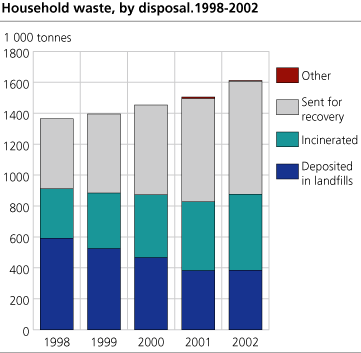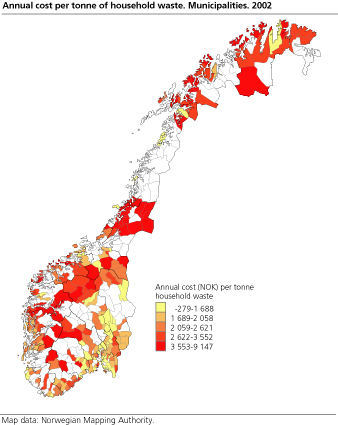Content
Published:
This is an archived release.
Household waste increases more than ever
There was an increase in amount of household waste by 7 per cent from 2001 to 2002. This is a greater increase than the trend for the last ten years.
In all, 1.6 million tonnes of household waste was collected in 2002, which is 100 000 tonnes, or 6.6 per cent, more than the year before. 45 per cent was sorted for recovery, compared with 44 per cent the year before.
The amount of waste is increasing even more
Last year each Norwegian delivered on average 354 kilos of household waste, which is 19 kilos more than in 2001. The increase from 2000 to 2001 was 11 kilos, a greater increase than the trend for the last ten years.
and less increase in sorting
A total of 732 000 tonnes of household waste, or 45 per cent, were sorted for recovery in 2002. This is an increase of just 1 percentage point from the year before. On average each Norwegian sorted 161 kilos of waste in 2002 compared to 149 kilos in 2001.
Here sorted for recovery means sorted at home or at waste disposal plants. After sorting, the waste is usually recycled, composted or incinerated for energy, but residues from sorting are in most places disposed of in landfills.
more waste was incinerated
After several years with decreasing amounts of waste sent to landfills, there was a little increase from 2001 to 2002 by 1856 tonnes. A total of about 384 000 tonnes was sent to landfills. While 85 per cent of all household waste in the most northern part of Norway was sent to landfills, nothing was reported sent to landfills in Oslo. In 2002 about 492 000 tonnes of household waste was incinerated, an increase of 11 per cent since 2001.
Better collection service
All municipalities in Norway now have a kind of recycling scheme. The most common material fractions for sorting at home are paper, which is collected in 393 out of 434 municipalities, and biodegradables, which is collected in 307 municipalities. Corresponding figures for 2001 were 385 municipalities for paper and unchanged for biodegradables. Hazardous waste was collected at home or at receiving stations (bring/drop off-sites) in 425 municipalities in 2001. 37 municipalities had no separate waste collection at home in 2001.
403 out of 434 municipalities offered free delivering of one or more sorted material fractions at receiving stations, compared with 299 in 2001. This arrangement was financed by the ordinary tax.
Although a majority of the Norwegian municipalities have outsourced their waste collection and disposal service, the municipalities themselves collect the waste collection fees in most cases. Collection and disposal of household waste cost the municipalities a total of NOK 3 011 million in 2002. NOK 2 761 million, or 92 per cent of the cost, were collected in fees. The average cost of collecting and disposing of a tonne of household waste in 2002 was hence NOK 1 867. The map shows how this cost varies between the different Norwegian municipalities. In 2003 the average collection and disposal fee for Norwegian households is 1 718 NOK. Municipalities with white colour have not reported data for 2002.
Since the municipalities to a large extent buy the collection and disposal services from inter-municipal or private companies, the municipalities themselves invest a limited amount of money in waste collection and disposal equipment and facilities. The total investments of this kind in 2002 amounted to NOK 169 million, or NOK 37 per capita. 111 million were invested in treatment plants and 58 million in collection equipment.
The figures are compiled from a census that Statistics Norway conducted in all municipalities and inter-municipal waste management companies in Norway excl. Svalbard.
| Household waste. 1992-2002. Tonnes and kilo by municipality |
| The whole country | Total | Sent for recovery | |||||||||||||||||||||||||||||||||||||
|---|---|---|---|---|---|---|---|---|---|---|---|---|---|---|---|---|---|---|---|---|---|---|---|---|---|---|---|---|---|---|---|---|---|---|---|---|---|---|---|
| Total | Kilo per inhabitant | Total | Kilo per inhabitant | ||||||||||||||||||||||||||||||||||||
| 19921 | 1 012 192 | 237 | 86 363 | 20 | |||||||||||||||||||||||||||||||||||
| 19951 | 1 173 643 | 269 | 212 689 | 49 | |||||||||||||||||||||||||||||||||||
| 19961 | 1 195 274 | 274 | 260 234 | 60 | |||||||||||||||||||||||||||||||||||
| 19971 | 1 259 333 | 287 | 365 898 | 83 | |||||||||||||||||||||||||||||||||||
| 1998 | 1 363 909 | 309 | 452 698 | 102 | |||||||||||||||||||||||||||||||||||
| 1999 | 1 396 674 | 314 | 524 156 | 118 | |||||||||||||||||||||||||||||||||||
| 2000 | 1 451 590 | 324 | 581 056 | 130 | |||||||||||||||||||||||||||||||||||
| 2001 | 1 506 715 | 335 | 668 393 | 148 | |||||||||||||||||||||||||||||||||||
| 2002 | 1 612 674 | 354 | 731 632 | 161 | |||||||||||||||||||||||||||||||||||
| 1 | The figures are scaled down to correct for interference of waste from the industries. |
| Source: Waste statistics, Statistics Norway. | |
Tables:
- Table 1 Houshold waste, by county and municipality. 1995, 1998, 2001 and 2002. Per cent, waste sent for recovery, include energy recovery
- Table 2 Household waste sent for recovery, by material. County and municipality. 2001. Tonnes
- Table 3 Household waste, by disposal. 1992-2001. 1000 tonnes
- Table 4 Percentage of inhabitants living in municipalities where kerbside collection of sorted fractions is offered
- Table 5 Investment, costs, income, cost coverage ratio and number of inhabitants, by county figures. 2002
Contact
-
Camilla Skjerpen
E-mail: camilla.skjerpen@ssb.no
tel.: (+47) 48 22 72 14
-
Mona E. Onstad
E-mail: mona.onstad@ssb.no
tel.: (+47) 48 59 61 86


